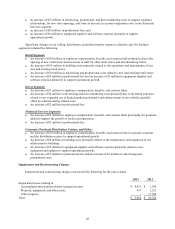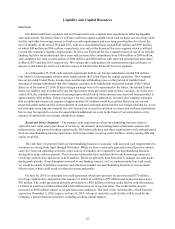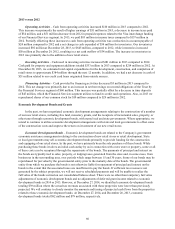Cabela's 2014 Annual Report Download - page 65
Download and view the complete annual report
Please find page 65 of the 2014 Cabela's annual report below. You can navigate through the pages in the report by either clicking on the pages listed below, or by using the keyword search tool below to find specific information within the annual report.55
Liquidity and Capital Resources
Overview
Our Retail and Direct segments and our Financial Services segment have significantly differing liquidity
and capital needs. We believe that we will have sufficient capital available from cash on hand, our revolving credit
facility, and other borrowing sources to fund our cash requirements and near-term growth plans for at least the
next 12 months. At the end of 2014 and 2013, cash on a consolidated basis totaled $143 million and $199 million,
of which $49 million and $94 million, respectively, was cash at the Financial Services segment which is utilized
to meet this segment’s liquidity requirements. In 2014, our Financial Services segment renewed one of its variable
funding facilities for an additional three years and increased the commitment from $350 million to $500 million,
and completed two term securitizations of $300 million and $400 million with expected principal payment dates
in March 2017 and July 2019, respectively. We evaluate the credit markets for securitizations and certificates of
deposit to determine the most cost effective source of funds for the Financial Services segment.
As of December 27, 2014, cash and cash equivalents held by our foreign subsidiaries totaled $74 million.
Our intent is to permanently reinvest these funds outside the United States for capital expansion. The Company
has not provided United States income taxes and foreign withholding taxes on the portion of undistributed
earnings of foreign subsidiaries that the Company considers to be indefinitely reinvested outside of the United
States as of December 27, 2014. If these foreign earnings were to be repatriated in the future, the related United
States tax liability may be reduced by any foreign income taxes previously paid on these earnings. As of the year
ended 2014, the cumulative amount of earnings upon which United States income taxes have not been provided is
approximately $166 million. If those earnings were not considered indefinitely invested, the Company estimates
that an additional income tax expense of approximately $33 million would be recorded. Based on our current
projected capital needs and the current amount of cash and cash equivalents held by our foreign subsidiaries, we do
not anticipate incurring any material tax costs beyond our accrued tax position in connection with any repatriation,
but we may be required to accrue for unanticipated additional tax costs in the future if our expectations or the
amount of cash held by our foreign subsidiaries change.
Retail and Direct Segments – The primary cash requirements of our merchandising business relate to
capital for new retail stores, purchases of inventory, investments in our management information systems and
infrastructure, and general working capital needs. We historically have met these requirements with cash generated
from our merchandising business operations, borrowings under revolving credit facilities, and by issuing debt and
equity securities.
The cash flow we generate from our merchandising business is seasonal, with our peak cash requirements for
inventory occurring from April through November. While we have consistently generated overall positive annual
cash flow from our operating activities, other sources of liquidity are required by our merchandising business
during these peak cash use periods. These sources historically have included short-term borrowings under our
revolving credit facility and access to debt markets. While we generally have been able to manage our cash needs
during peak periods, if any disruption occurred to our funding sources, or if we underestimated our cash needs,
we would be unable to purchase inventory and otherwise conduct our merchandising business to its maximum
effectiveness, which could result in reduced revenue and profits.
On June 18, 2014, we amended our credit agreement which now provides for an unsecured $775 million
revolving credit facility and permits the issuance of letters of credit up to $75 million and swing line loans up to
$30 million. The credit agreement formerly provided for a $415 million revolving credit facility with the issuance
of letters of credit up to $100 million and a $20 million limit on swing line loans. The credit facility may be
increased to $800 million subject to certain terms and conditions. The term of the credit facility, which formerly
expired on November 2, 2016, expires on June 18, 2019. Advances under the credit facility will be used for the
Company’s general business purposes, including working capital support.
























